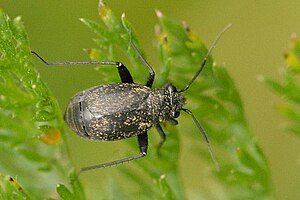Orthocephalus coriaceus
| Orthocephalus coriaceus | ||||||||||||
|---|---|---|---|---|---|---|---|---|---|---|---|---|

Orthocephalus coriaceus |
||||||||||||
| Systematics | ||||||||||||
|
||||||||||||
| Scientific name | ||||||||||||
| Orthocephalus coriaceus | ||||||||||||
| ( Fabricius , 1777) |
Orthocephalus coriaceus is a species of bug from the family of soft bugs (Miridae).
features
The bugs are 5.0 to 5.5 millimeters (males) or 4.1 to 5.5 millimeters (females). The species of the genus Orthocephalus are very dark in color and their physique is rather stocky and adapted to jumping. The feelers are completely black. Orthocephalus coriaceus can be distinguished from the similar species Orthocephalus saltator by the completely black rails ( tibia ) of the hind legs. In the males, the hemielytra's corium is yellowish on the inside. Both sexes have fully winged (macroptere) and those with shortened (brachypteric) wings.
Occurrence and habitat
The species is distributed in Europe from southern Scandinavia to the northern edge of the Mediterranean and east to Russia, Ukraine and the Balkans. It was introduced into North America by humans. It is widespread in Germany and mostly occurs frequently. In Austria it is absent in the Pannonian East. The herb layer is colonized by dry, warm, open habitats, especially on sandy soils, but it can also be found on other soils. They are often to be found on ruderal areas, fallow land, fields and roadsides.
Way of life
The bugs live on various daisy family (Asteraceae) such as daisies ( Leucanthemum ), wild flowers ( Tanacetum ), hawkweed ( Hieracium ), yarrow ( Achillea ), knapweed ( Centaurea ), Artemisia . The bugs suckle on the leaves and stems as well as on the reproductive organs of the plants. In North America, the species occasionally occurs as a pest in horticulture. The adult bugs can be seen from the beginning of June to the end of August, sometimes even at the beginning of September. The females pierce their eggs individually or in small groups into the stems of the host plants.
supporting documents
Individual evidence
- ^ A b c Ekkehard Wachmann , Albert Melber, Jürgen Deckert: Bugs. Volume 2: Cimicomorpha: Microphysidae (lichen bugs), Miridae (soft bugs) (= The animal world of Germany and the adjacent parts of the sea according to their characteristics and their way of life . 75th part). Goecke & Evers, Keltern 2006, ISBN 3-931374-57-2 , p. 156 ff .
- ^ Orthocephalus coriaceus. British Bugs, accessed January 4, 2015 .
literature
- Ekkehard Wachmann , Albert Melber, Jürgen Deckert: Bugs. Volume 2: Cimicomorpha: Microphysidae (lichen bugs), Miridae (soft bugs) (= The animal world of Germany and the adjacent parts of the sea according to their characteristics and their way of life . 75th part). Goecke & Evers, Keltern 2006, ISBN 3-931374-57-2 .
Web links
- Orthocephalus coriaceus in Fauna Europaea. Retrieved January 4, 2015
